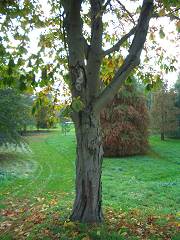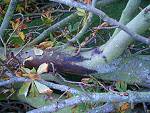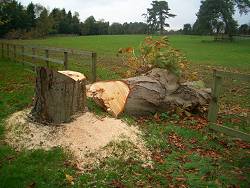How to manage trees and sites affected by bleeding canker
Forest Research is involved in several studies to understand the nature of this disease and its spread. This work is essential for developing evidence-based disease management.
In the meantime, we recommend you use follow these precautionary guidelines to reduce the possible risk of spreading infection to neighbouring trees or transferring it to other sites.
1. Survey
 If your site has a significant number of horse chestnut trees you should carry out a survey to assess the number of affected trees.
If your site has a significant number of horse chestnut trees you should carry out a survey to assess the number of affected trees.
The survey should record:
- Number of trees on site
- Mapped location of the trees
- Number of affected trees
- Circumference of affected trees (measured at breast height in cm) as a rough guide to age
- Extent of the symptoms on each affected tree (number of bleeding lesions and extent of crown symptoms)
- Photographs of infected trees
- Additional information (e.g. other nearby tree species, ground disturbance, etc)
Download a template form for your survey.
2. Take action
 Following these guidelines will maximise the chance of trees recovering from infection and also help to limit the spread of any infectious agent to other trees.
Following these guidelines will maximise the chance of trees recovering from infection and also help to limit the spread of any infectious agent to other trees.
- Monitor trees with light to moderate bleeding and vigorous crowns, unless there are immediate concerns for safety – some trees may recover
- You can remove trees on sites with a limited number of infected trees, although we do not yet have evidence that such measures will be successful
- Small trees are more likely to succumb to the disease because they can be girdled in less time than larger specimens, so the removal of young trees is a justifiable precaution
- Avoid pruning or cutting out infected bark
- Do not disturb the soil around trees or apply fertilisers
- If you decide to treat, fell or prune trees, begin with the least affected specimens and progress towards the most heavily infected
- Always disinfect tools with methylated spirit, a solution of domestic bleach or a commercial product after working on affected trees and when moving from site to site
- Where practicable, hose off machinery and vehicles that have been on infected sites
- Avoid bringing in young horse chestnuts to plant especially if a site is disease-free; plant conkers from the same site instead
3. Dispose of potentially infected material
- Felled trees and affected branches should be destroyed on site, either by burning or burying
- If immediate disposal is not possible, store logs and away from other trees
- Do not retain logs cut from diseased trees, even for firewood
- Avoid chipping infected material – this may create aerosols containing bacteria and spread the disease
- If composting, take infected material directly to the processing facility, so it is chipped without spreading infection and composted in a well controlled heap with a minimal temperature of 60 °C throughout the heap
4. Replant
Our surveys and research reveal that where owners have replaced mature diseased trees with young horse chestnuts, some of the replanted trees have shown signs of infection within a few years. We therefore do not recommend replanting with the same species.
On the basis of some small-scale surveys, both white (Aesculus hippocastanum) and red horse chestnuts (Aesculus x carnea) seem similarly affected by the disease. Aesculus turbinata can also develop the disease, but Aesculus indica has not been found with symptoms of bleeding canker.
 If your site has a significant number of horse chestnut trees you should carry out a survey to assess the number of affected trees.
If your site has a significant number of horse chestnut trees you should carry out a survey to assess the number of affected trees. Following these guidelines will maximise the chance of trees recovering from infection and also help to limit the spread of any infectious agent to other trees.
Following these guidelines will maximise the chance of trees recovering from infection and also help to limit the spread of any infectious agent to other trees.